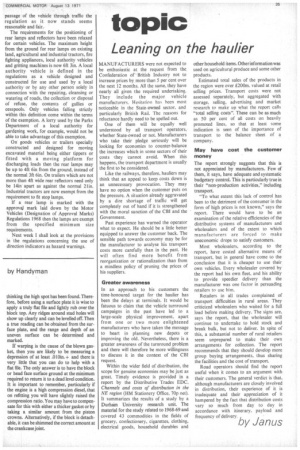topic
Page 37

If you've noticed an error in this article please click here to report it so we can fix it.
Leaning on the haulier
MANUFACTURERS were not expected to be enthusiastic at the request from the Confederation of British Industry not to increase prices by more than 5 per cent over the next 12 months. All the same. they have nearly all given the required undertaking. They include the major vehicle manufacturers. Hesitation has been most noticeable in the State-owned sector, and particularly British Rail. The reasons for reluctance hardly need to be spelled out.
One of them will be equally well understood by all transport operators, whether State-owned or not. Manufacturers who take their pledge seriously will be looking for economies to counter-balance the increases which in some sectors of their eosts -they cannot avoid. When this happens, the transport department is usually the first to be considered.
Like the railways, therefore, hauliers may think that an appeal to keep costs down is an unnecessary provocation. They may have no option when the customer puts on the pressure. A situation already aggravated by a dire shortage of traffic will get completely out of hand if it is strengthened with the moral sanction of the CBI and the Government.
Past experience has warned the operator what to expect. He should be a little better equipped to answer the customer back. The sensible path towards economy may be for the manufacturer to analyse his transport costs more carefully than in the past. He will often find more benefit from reorganization or rationalization than from a mindless policy of pruning the prices of his suppliers.
Greater awareness In an approach to his customers the time-honoured target for the haulier has been the delays at terminals. It would be fatuous to claim that the vehicle turnround campaigns in the past have led to a large-scale physical improvement, apart from one or two more enlightened manufacturers who have taken the message to heart in planning new depots or improving the old. Nevertheless, there is a greater awareness of the turnround problem and there will therefore be more willingness to discuss it in the context of the CBI request.
Within the wider field of distribution, the scope for genuine economies may be just as great. Timely evidence is provided in a report by the Distributive Trades EDC, Channels and costs of distribution in the NE region (HM Stationery Office, 70p net). It summarizes the results of a study by a Durham University research unit. The material for the study related to 1968-69 and covered 43 commodities in the fields of grocery, confectionery, cigarettes, clothing, electrical goods, household durables and
other household items. Other information was used on agricultural produce and some other products.
Estimated total sales of the products in the region were over £200m. valued at retail selling prices. Transport costs were not assessed separately, but aggregated with storage, selling, advertising and market research to make up what the report calls "total selling costs". These can be as much as 50 per cent of all costs on heavily promoted lines, so that at least some indication is seen of the importance of transport to the balance sheet of a company.
May have cost the customer money The report strongly suggests that this is not appreciated by manufacturers. Few of them, it says, have adequate and systematic budgetary control. This is particularly true in their "non-production activities," including transport.
"To what extent this lack of control has been to the detriment of the consumer in the form of high prices is not known," says the report. There would have to be an examination of the relative efficiencies of the distributive systems of manufacturers and wholesalers and of the extent to which manufacturers are forced to make uneconomic drops to satisfy customers.
Most wholesalers, according to the report, have costed alternative means or transport, but in general have come to the conclusion that it is cheaper to use their own vehicles. Every wholesaler covered by the report had his own fleet, and his ability to provide speedier delivery than the manufacturer was one factor in persuading retailers to use him.
Retailers in all trades complained of transport difficulties in rural areas. They criticized wholesalers who waited for a full load before making delivery. The signs are, says the report, that the wholesaler will continue to undertake to hold stock and break bulk, but not to deliver. In spite of this, a substantial number of rural retailers seem unprepared to make their own arrangements for collection. The report recommends that they should develop more group buying arrangements, thus sharing the facilities and the cost of transport.
Road operators should find the report useful when it comes to an argument with their customers. The general verdict is that, although manufacturers are closely involved in distribution, their experience of it is inadequate and their appreciation of it hampered by the fact that distribution costs vary so much from day to day in accordance with itinerary, payload and frequency of delivery.
by Janus




















































































